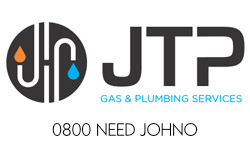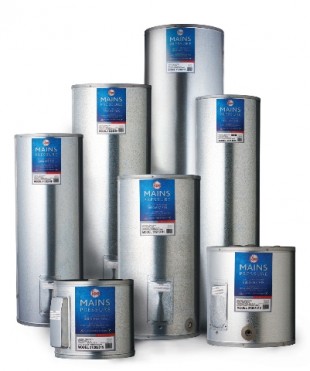-
LOW PRESSURE HOT WATER CYLINDERS
-
MEDIUM PRESSURE HOT WATER CYLINDERS
-
MAINS PRESSURE HOT WATER CYLINDERS
LOW PRESSURE CYLINDERS
Copper internal cylinders, which are insulated
and have a galvanised outer casing.
Before explaining the workings of hot water cylinders you must understand the principle of thermal
expansion. When cold water is heated in a cylinder the volume increases by as much as 1 – 3 %.
This pressure cannot be safely contained within a hot water cylinder with out the use of an open
vent to the atmosphere or a pressure relief safety valve in conjunction with a cold water expansion
valve.
The pressure in a hot water cylinder can be achieved in several ways:
1) The oldest and most common is the header tank open vented system.
In this system, water from the mains supply is fed to a header tank in the roof space by way of a
ballcock. The cold water stored in the header tank provides the “head” of pressure necessary to
achieve hot water flow at the taps.
The head available is determined by the the height of the water level in the tank above the hot
fixtures ( taps ,shower etc).Usually 2- 3 metres (20 – 30 kpa) to a maximum for a low pressure
cylinder of 7.6 metres or 76 kpa.
Advantages of this system are it’s simplicity, lack of maintenance and fluctuations, it’s cheap and
the fact that you have a reserve of water if needed.
Disadvantages are the low head available especially in low pitched roofs, the possibility of air
locks, long wait for hot water at taps and smaller range of tapware to choose from.

2) The other way of achieving pressure in a low pressure hot water cylinder (hwc) is by a pressure
reducing valve, either open or valve vented.
In this system the mains supply is installed directly into the bottom of the hwc via an isolating
valve/filter and then an adjustable pressure reducing valve (circular brass valve that looks like a
u.f.o). This valve (utilising a spring and diaphragm) lets water enter the cylinder only when the
pressure on the outlet side falls i.e. when a hot tap is turned on. The head available is determined
by the height of the water held in the open ended vent pipe.

Valve vented: Instead of having an open ended vent pipe 7.6 meters long sticking out of the
roofline, a pressure relief safety valve can be fitted in conjunction with a cold water expansion valve
to achieve the same result.
This relief valve (usually at the top of the hwc) simulates through a diaphragm and a spring 7.6
meters of head pressure and enables us to wind up the pressure reducing valve to get an increase
in pressure. The cold water expansion valve is factory set slightly lower than the relief valve so that when the pressure increases in the cylinder due to thermal expansion only cold water will be vented.
Advantages: can be installed to increase the pressure of header tank supplied hot water cylinders,
better pressure there fore better showers and quicker hot water delivery times.
Disadvantages: increased maintenance, can get pressure fluctuations when other taps are turned
on, valve venting can’t be fitted to a wet back hwc and the likelihood that older cylinders may leak
with the increased pressure.
MEDIUM PRESSURE HOT WATER CYLINDERS are made of heavier guage copper and use the
same valves as low pressure valve vented systems but they are rated to a higher pressure of 12
metres head or 120 kpa.
Advantages are better pressure than low pressure and cheaper than mains pressure.
Disadvantages are limited choice of tapware available, increased maintenance of valves, still not
mains pressure hot water.
MAINS PRESSURE HOT WATER CYLINDERS
This type of cylinder is the most common in hotels and new homes. They have a steel inner
cylinder which is lined in enamel (glass), 50mm of insulation and a colour steel outer lining with
plastic top and bottom domes. They operate at approximately 500 kpa pressure at the hot taps,
which is just slightly lower than the cold water pressure. Special safety valves are needed as this
cylinder operates at a much higher pressure than the two types mentioned above, this is why it has
a steel inner tank.
Advantages: Most new tapware is only rated for mains pressure so you have more options to
choose from. The mains pressure tapware is often cheaper than low or unequal pressure. You can
install massaging shower heads and multi heads to your shower. The Dux Mains Pressure Cylinder
can be installed outside there fore saving precious storage space inside. Overcomes the problem
of old pipework and poor hot delivery times, reduced fluctuations and better showers upstairs. Can
be supplied with “night rate” heating if the cylinder capacity is large enough also multiple size
options and variations.
Disadvantages: Heavier to maneuver, more expensive than low or medium pressure.
TEMPERING VALVES
The tempering valve is designed to mix cold water into the hot water so that the water delivered
from the hot water cylinder to the taps never exceeds a set temperature.
The Building Code requires that the water delivered to sanitary fixtures used for personal hygiene
purposes shall not exceed 45 degrees C for early childhood centres, schools and old people’s
homes and 55 degrees C for all other buildings.
The water supply to kitchens and laundries is not required to be tempered.
The use of tempering valves ensures the safety of hot water users independently of the water
stored in the hot water cylinder.
Something to think about (adults)
It takes 1 second to obtain a full thickness burn with 65 degrees C hot water.
It takes 22 seconds to obtain a full thickness burn with 55 degrees C hot water.
(Children)
It takes 0.5 seconds for a full thickness burn with 65 degrees C hot water.
And takes 10 seconds for a full thickness burn with 55 degrees C hot water.
You may be thinking that you can just turn down the thermostat to 55 degrees C but this will limit
the quantity of hot water and also not comply with the Building Code. Which states that water must
not be stored at a temperature less than 60 degrees C to prevent the growth of legionella bacteria.
Also on old hot water cylinders the thermostat pocket gets scaled up which makes the thermostat
fail to maintain the correct set temperature there fore the water delivered is often much hotter than
the thermostat setting.
Wet back hot water cylinders (and solar) are classed as uncontrolled as the thermostat will shutoff
when the fire (panel) or element brings the temperature up to the dial setting. But the fire (or panel)
will still continue to heat the water and in some cases cause the water to boil within the hot water
cylinder. There fore you can get scalding hot water and steam at the hot taps in the worst case
scenario. THIS WOULD NOT HAPPEN WITH A TEMPERING VALVE FITTED.
When are tempering valves needed:
* When a new solid fuel heater with a wet back is fitted.
* A new (not replacement) wet back fitted to an existing solid fuel heater.
* When an additional personal hygiene fixture is installed (i.e. shower unit). In this instance it is only
the new fixture that needs to be tempered but it is easier to temper all the fixtures.
* An owner wants to change the use of an existing building from private dwelling to early childcare
or retirement home.
* Any new hot water cylinders that supply personal hygiene fixtures or appliances (not direct
replacements).
* Bathroom alterations where personal hygiene fixtures are being shifted to new positions.






